tire pressure MAZDA MODEL MPV 2005 Owners Manual (in English)
[x] Cancel search | Manufacturer: MAZDA, Model Year: 2005, Model line: MODEL MPV, Model: MAZDA MODEL MPV 2005Pages: 336, PDF Size: 5.31 MB
Page 122 of 336
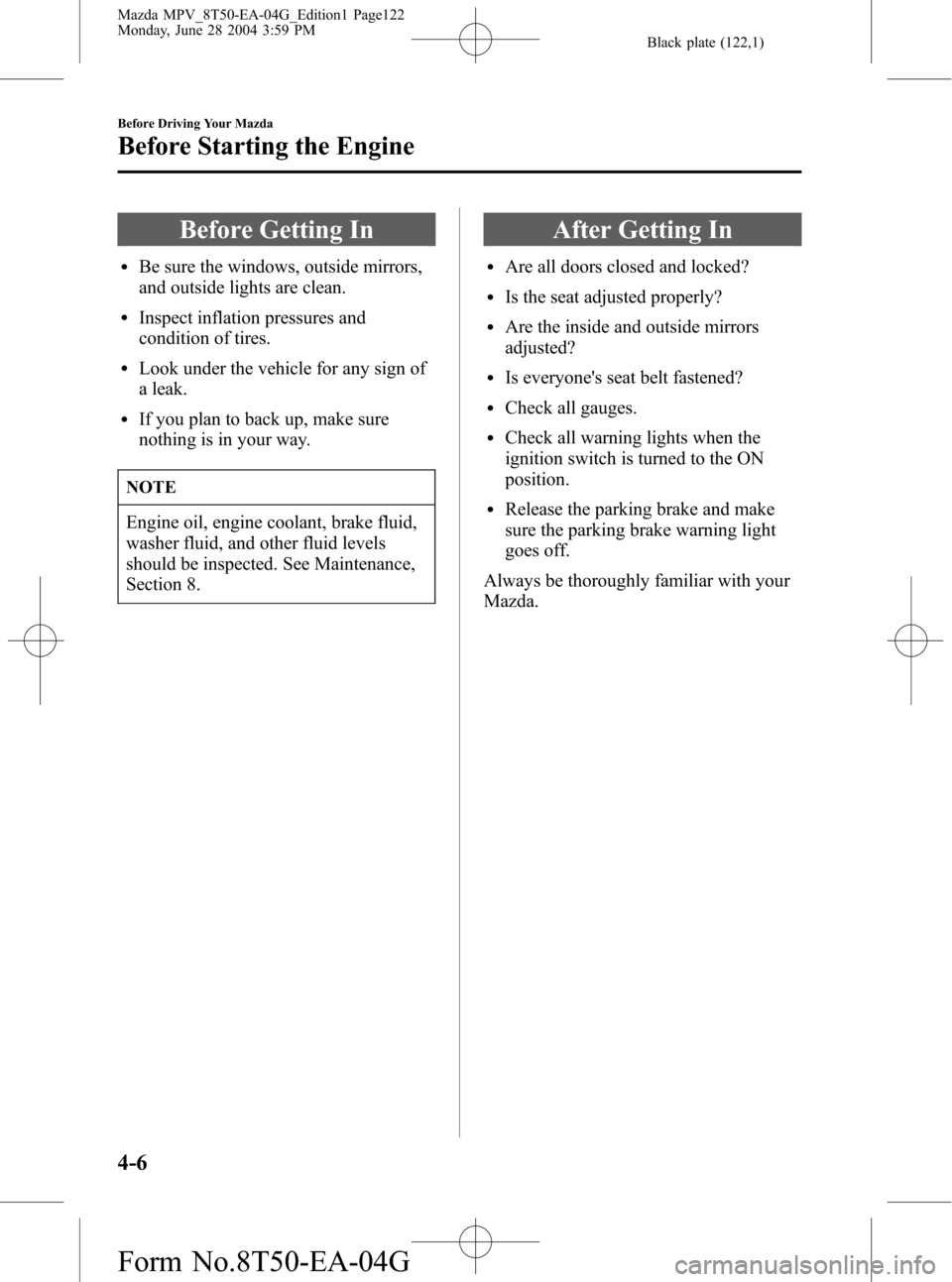
Black plate (122,1)
Before Getting In
lBe sure the windows, outside mirrors,
and outside lights are clean.
lInspect inflation pressures and
condition of tires.
lLook under the vehicle for any sign of
a leak.
lIf you plan to back up, make sure
nothing is in your way.
NOTE
Engine oil, engine coolant, brake fluid,
washer fluid, and other fluid levels
should be inspected. See Maintenance,
Section 8.
After Getting In
lAre all doors closed and locked?
lIs the seat adjusted properly?
lAre the inside and outside mirrors
adjusted?
lIs everyone's seat belt fastened?
lCheck all gauges.
lCheck all warning lights when the
ignition switch is turned to the ON
position.
lRelease the parking brake and make
sure the parking brake warning light
goes off.
Always be thoroughly familiar with your
Mazda.
4-6
Before Driving Your Mazda
Before Starting the Engine
Mazda MPV_8T50-EA-04G_Edition1 Page122
Monday, June 28 2004 3:59 PM
Form No.8T50-EA-04G
Page 125 of 336
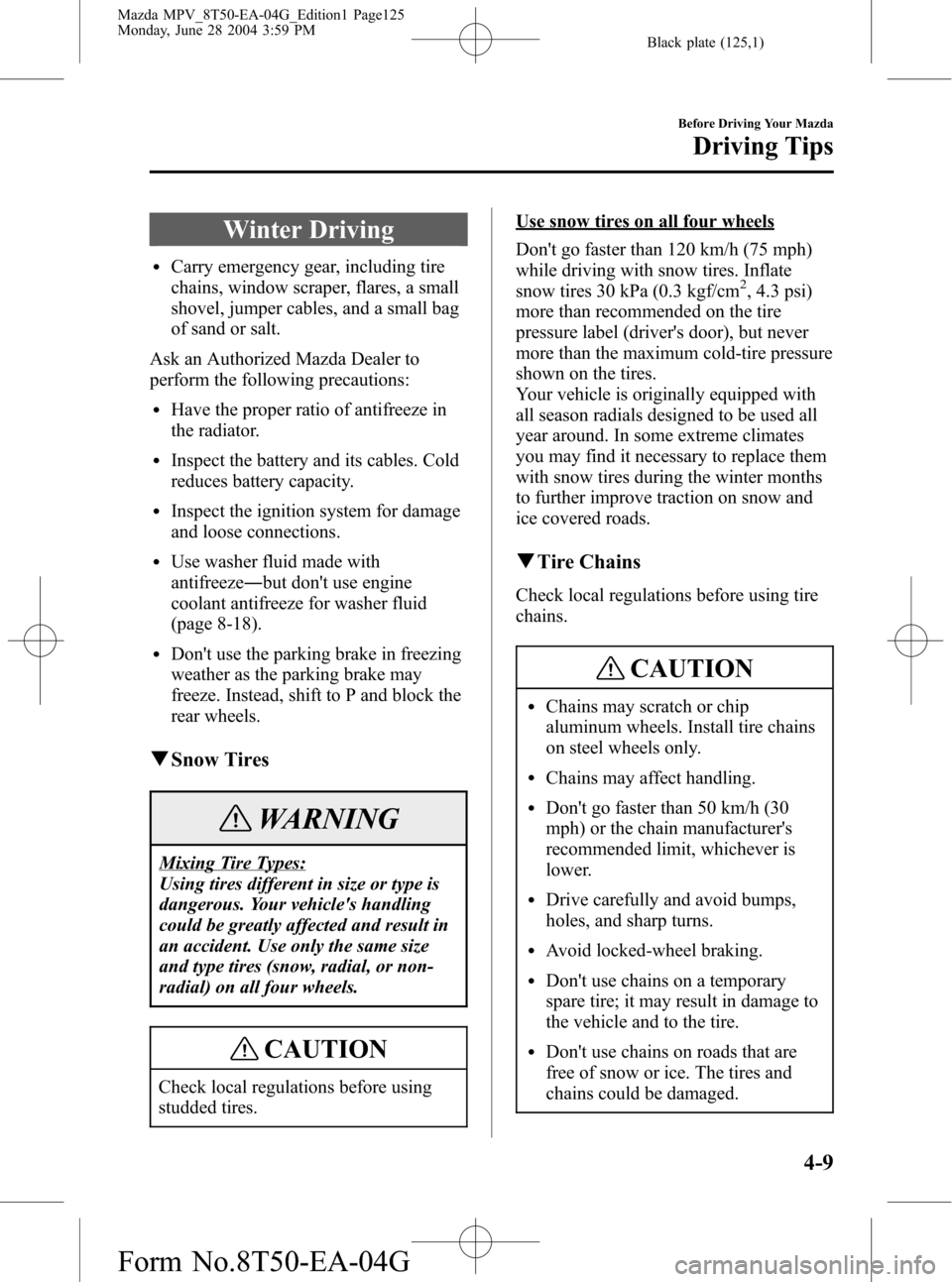
Black plate (125,1)
Winter Driving
lCarry emergency gear, including tire
chains, window scraper, flares, a small
shovel, jumper cables, and a small bag
of sand or salt.
Ask an Authorized Mazda Dealer to
perform the following precautions:
lHave the proper ratio of antifreeze in
the radiator.
lInspect the battery and its cables. Cold
reduces battery capacity.
lInspect the ignition system for damage
and loose connections.
lUse washer fluid made with
antifreeze―but don't use engine
coolant antifreeze for washer fluid
(page 8-18).
lDon't use the parking brake in freezing
weather as the parking brake may
freeze. Instead, shift to P and block the
rear wheels.
qSnow Tires
WARNING
Mixing Tire Types:
Using tires different in size or type is
dangerous. Your vehicle's handling
could be greatly affected and result in
an accident. Use only the same size
and type tires (snow, radial, or non-
radial) on all four wheels.
CAUTION
Check local regulations before using
studded tires.
Use snow tires on all four wheels
Don't go faster than 120 km/h (75 mph)
while driving with snow tires. Inflate
snow tires 30 kPa (0.3 kgf/cm
2, 4.3 psi)
more than recommended on the tire
pressure label (driver's door), but never
more than the maximum cold-tire pressure
shown on the tires.
Your vehicle is originally equipped with
all season radials designed to be used all
year around. In some extreme climates
you may find it necessary to replace them
with snow tires during the winter months
to further improve traction on snow and
ice covered roads.
qTire Chains
Check local regulations before using tire
chains.
CAUTION
lChains may scratch or chip
aluminum wheels. Install tire chains
on steel wheels only.
lChains may affect handling.
lDon't go faster than 50 km/h (30
mph) or the chain manufacturer's
recommended limit, whichever is
lower.
lDrive carefully and avoid bumps,
holes, and sharp turns.
lAvoid locked-wheel braking.
lDon't use chains on a temporary
spare tire; it may result in damage to
the vehicle and to the tire.
lDon't use chains on roads that are
free of snow or ice. The tires and
chains could be damaged.
Before Driving Your Mazda
Driving Tips
4-9
Mazda MPV_8T50-EA-04G_Edition1 Page125
Monday, June 28 2004 3:59 PM
Form No.8T50-EA-04G
Page 131 of 336
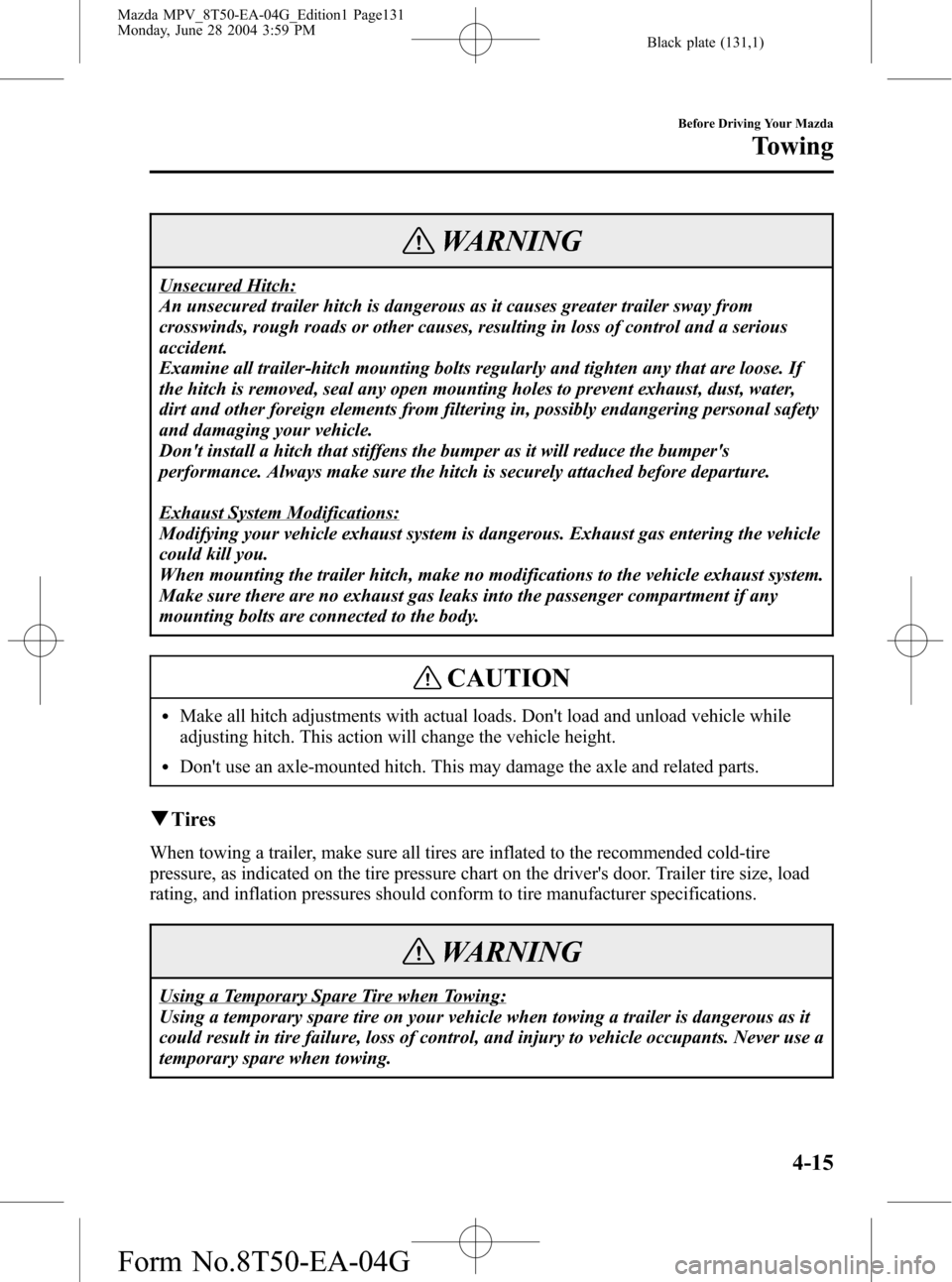
Black plate (131,1)
WARNING
Unsecured Hitch:
An unsecured trailer hitch is dangerous as it causes greater trailer sway from
crosswinds, rough roads or other causes, resulting in loss of control and a serious
accident.
Examine all trailer-hitch mounting bolts regularly and tighten any that are loose. If
the hitch is removed, seal any open mounting holes to prevent exhaust, dust, water,
dirt and other foreign elements from filtering in, possibly endangering personal safety
and damaging your vehicle.
Don't install a hitch that stiffens the bumper as it will reduce the bumper's
performance. Always make sure the hitch is securely attached before departure.
Exhaust System Modifications:
Modifying your vehicle exhaust system is dangerous. Exhaust gas entering the vehicle
could kill you.
When mounting the trailer hitch, make no modifications to the vehicle exhaust system.
Make sure there are no exhaust gas leaks into the passenger compartment if any
mounting bolts are connected to the body.
CAUTION
lMake all hitch adjustments with actual loads. Don't load and unload vehicle while
adjusting hitch. This action will change the vehicle height.
lDon't use an axle-mounted hitch. This may damage the axle and related parts.
qTires
When towing a trailer, make sure all tires are inflated to the recommended cold-tire
pressure, as indicated on the tire pressure chart on the driver's door. Trailer tire size, load
rating, and inflation pressures should conform to tire manufacturer specifications.
WARNING
Using a Temporary Spare Tire when Towing:
Using a temporary spare tire on your vehicle when towing a trailer is dangerous as it
could result in tire failure, loss of control, and injury to vehicle occupants. Never use a
temporary spare when towing.
Before Driving Your Mazda
Towing
4-15
Mazda MPV_8T50-EA-04G_Edition1 Page131
Monday, June 28 2004 3:59 PM
Form No.8T50-EA-04G
Page 244 of 336

Black plate (244,1)
qLocking Lug Nutsí
If your vehicle has optional antitheft
wheel lug nuts, one on each wheel will
lock the tires and you must use a special
key to unlock them. This key is attached
to the lug wrench and is stored with the
spare tire. Register them with the lock
manufacturer by filling out the card
provided in the glove box and mailing it
in the accompanying envelope. If you lose
your key, consult an Authorized Mazda
Dealer or use the lock manufacturer's
order form, which is with the registration
card.
Special key Antitheft lug nut
To remove an antitheft lug nut
1. Get the key for the locking lug nut.
2. Place it on top of the nut, and be sure
to hold the key square to it. If you hold
the key at an angle, you may damage
both key and nut. Don't use a power
impact wrench.
3. Place the lug wrench on top of the key
and apply pressure. Turn the wrench
counterclockwise.
To replace the nut
1. Place the key on top of the nut.
2. Place the lug wrench on top of the key,
apply pressure, and turn it clockwise.
qMounting the Spare Tire
1. Remove dirt and grime from the
mounting surfaces of the wheel and
hub, including the hub bolts, with a
cloth.
WARNING
Removing Dirt and Grime from
Wheels, Hubs and Hub Bolts:
When changing or replacing a tire,
not removing dirt and grime from the
mounting surfaces of the wheel, hub
and hub bolts is dangerous. The lug
nuts could loosen while driving and
cause the tire to come off, resulting in
an accident. Make sure the mounting
surfaces of the wheel, hub and lug
nuts are clean before changing or
replacing tires.
2. Mount the spare tire.
7-12
In Case of an Emergency
íSome models.
Flat Tire
Mazda MPV_8T50-EA-04G_Edition1 Page244
Monday, June 28 2004 4:0 PM
Form No.8T50-EA-04G
Page 246 of 336

Black plate (246,1)
WARNING
Metric Studs and Lug Nuts:
Because the wheel studs and lug nuts
on your Mazda have metric threads,
using a non-metric nut is dangerous.
On a metric stud, it would not secure
the wheel and would damage the stud,
which could cause the wheel to slip off
and cause an accident. Be sure to
reinstall the same nuts you removed or
replace them with metric nuts of the
same configuration.
Incorrect Tire Air Pressure:
Driving on tires with incorrect air
pressure is dangerous. Tires with
incorrect pressure could affect
handling and result in an accident.
Don't drive with any tires that have
incorrect air pressure. When you
check the regular tires' air pressure,
check the spare tire, too.
5. Put the flat tire in the special vinyl bag
and tie it at the top.
6. With the tire facing outward, punch a
hole through the vinyl bag and the
center hole, using the flat tire securing
bolt.
7. Lift the anchor clip on the back of
third-row seat.
8. Install the flat tire with the tire securing
bolt hooked in the anchor clip as
shown below.
7-14
In Case of an Emergency
Flat Tire
Mazda MPV_8T50-EA-04G_Edition1 Page246
Monday, June 28 2004 4:0 PM
Form No.8T50-EA-04G
Page 262 of 336
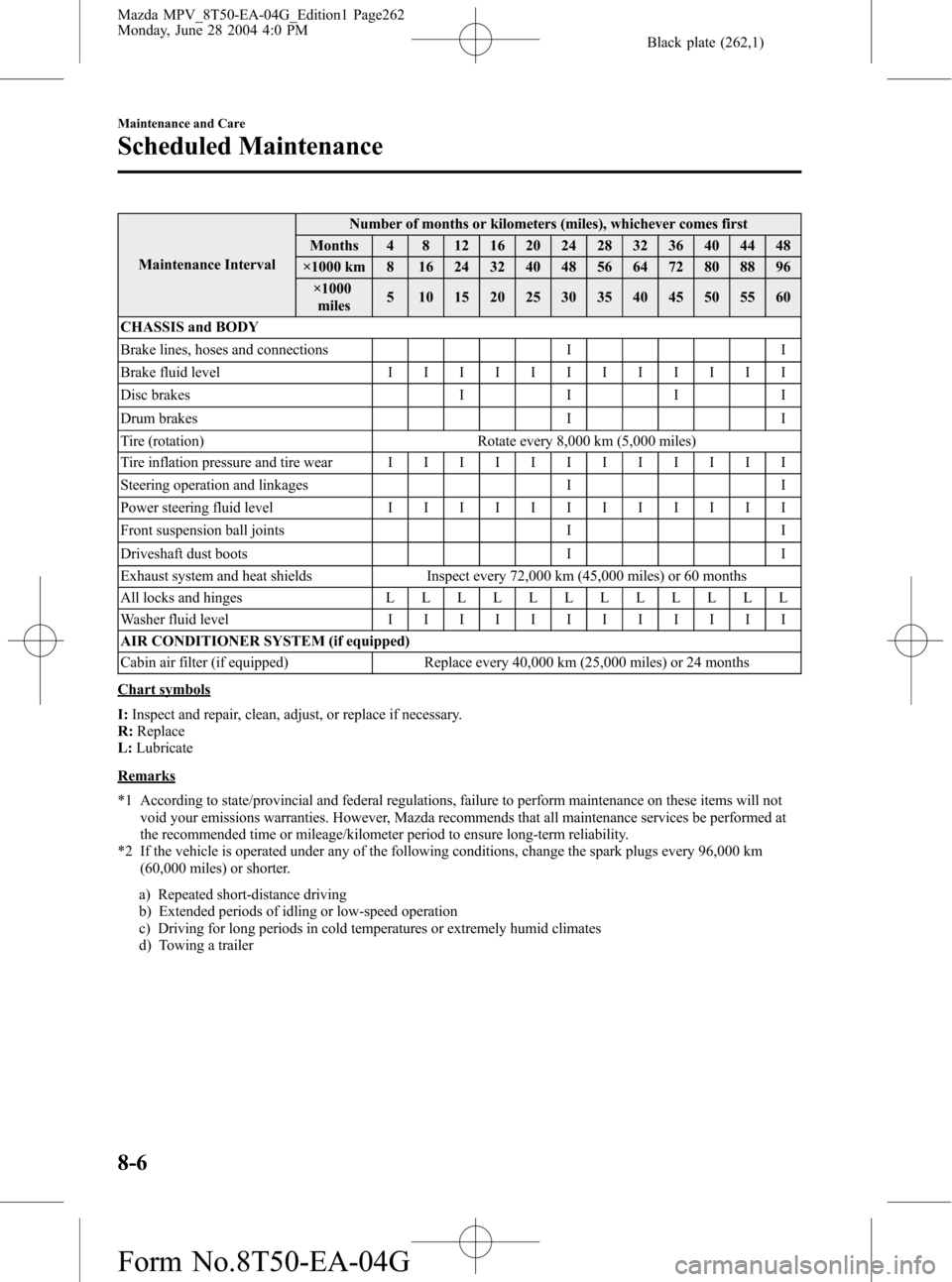
Black plate (262,1)
Maintenance IntervalNumber of months or kilometers (miles), whichever comes first
Months 4 8 12 16 20 24 28 32 36 40 44 48
×1000 km 8 16 24 32 40 48 56 64 72 80 88 96
×1000
miles5 1015202530354045505560
CHASSIS and BODY
Brake lines, hoses and connections I I
Brake fluid level IIIIIIIIIIII
Disc brakesIIII
Drum brakes I I
Tire (rotation) Rotate every 8,000 km (5,000 miles)
Tire inflation pressure and tire wear IIIIIIIIIIII
Steering operation and linkages I I
Power steering fluid level IIIIIIIIIIII
Front suspension ball joints I I
Driveshaft dust boots I I
Exhaust system and heat shields Inspect every 72,000 km (45,000 miles) or 60 months
All locks and hinges L L L L L L L L L L L L
Washer fluid level IIIIIIIIIIII
AIR CONDITIONER SYSTEM (if equipped)
Cabin air filter (if equipped) Replace every 40,000 km (25,000 miles) or 24 months
Chart symbols
I:Inspect and repair, clean, adjust, or replace if necessary.
R:Replace
L:Lubricate
Remarks
*1 According to state/provincial and federal regulations, failure to perform maintenance on these items will not
void your emissions warranties. However, Mazda recommends that all maintenance services be performed at
the recommended time or mileage/kilometer period to ensure long-term reliability.
*2 If the vehicle is operated under any of the following conditions, change the spark plugs every 96,000 km
(60,000 miles) or shorter.
a) Repeated short-distance driving
b) Extended periods of idling or low-speed operation
c) Driving for long periods in cold temperatures or extremely humid climates
d) Towing a trailer
8-6
Maintenance and Care
Scheduled Maintenance
Mazda MPV_8T50-EA-04G_Edition1 Page262
Monday, June 28 2004 4:0 PM
Form No.8T50-EA-04G
Page 263 of 336

Black plate (263,1)
Owner Maintenance Schedule
The owner or a qualified service technician should make these vehicle inspections at the
indicated intervals to ensure safe and dependable operation.
Bring any problem to the attention of an Authorized Mazda Dealer or qualified service
technician as soon as possible.
qWhen Refueling
lBrake fluid level (page 8-15)
lEngine coolant level (page 8-13)
lEngine oil level (page 8-11)
lWasher fluid level (page 8-18)
qAt Least Monthly
Tire inflation pressures (page 8-27)
qAt Least Twice a Year (For Example, Every Spring and Fall)
lAutomatic transaxle fluid level (page 8-17)
lPower steering fluid level (page 8-16)
You can do the following scheduled maintenance items if you have some mechanical
ability and a few basic tools and if you closely follow the directions in this manual.
lAir filter (page 8-20)
lEngine coolant (page 8-13)
lEngine oil (page 8-11)
Maintenance and Care
Owner Maintenance
8-7
Mazda MPV_8T50-EA-04G_Edition1 Page263
Monday, June 28 2004 4:0 PM
Form No.8T50-EA-04G
Page 282 of 336
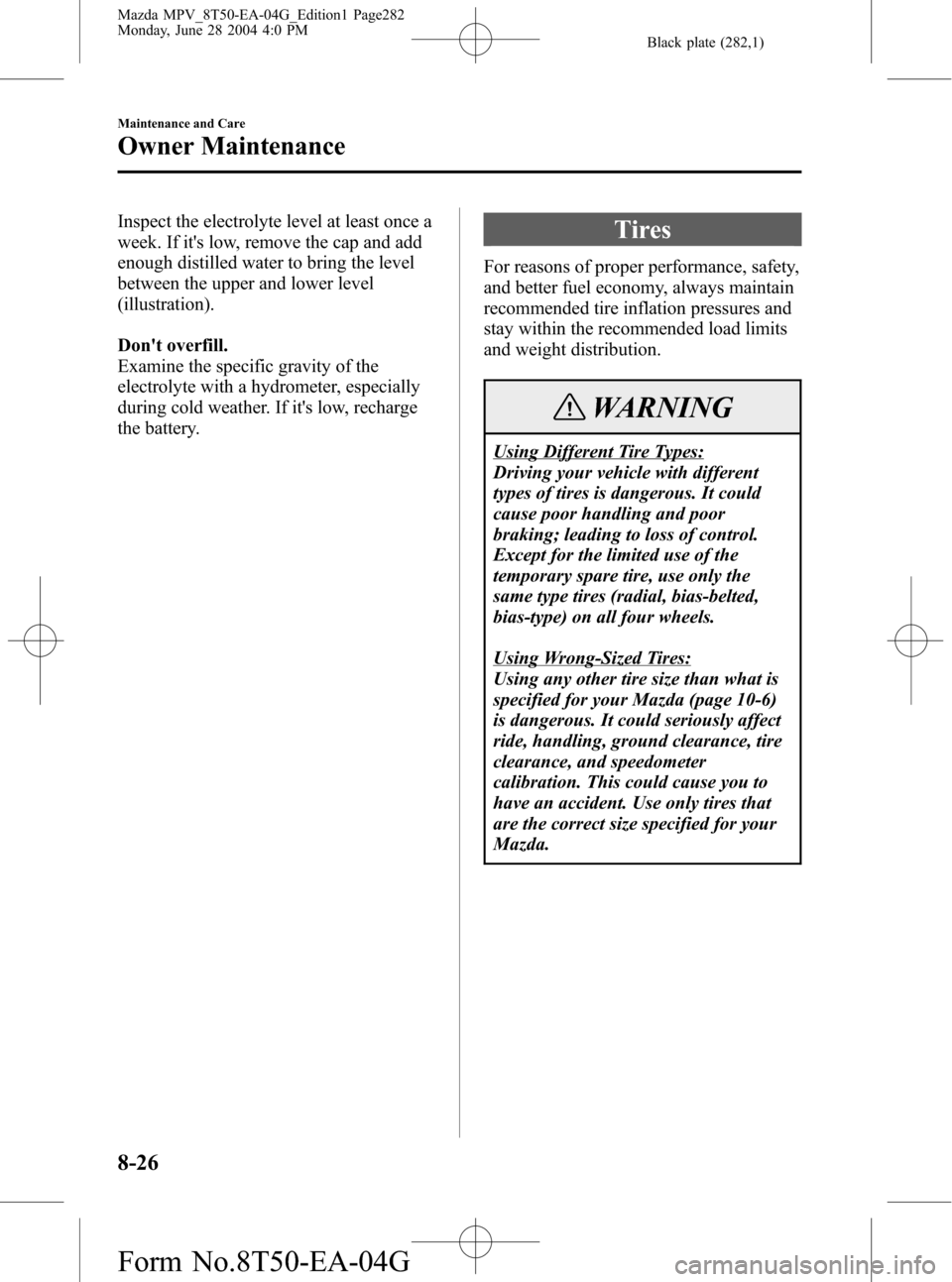
Black plate (282,1)
Inspect the electrolyte level at least once a
week. If it's low, remove the cap and add
enough distilled water to bring the level
between the upper and lower level
(illustration).
Don't overfill.
Examine the specific gravity of the
electrolyte with a hydrometer, especially
during cold weather. If it's low, recharge
the battery.Tires
For reasons of proper performance, safety,
and better fuel economy, always maintain
recommended tire inflation pressures and
stay within the recommended load limits
and weight distribution.
WARNING
Using Different Tire Types:
Driving your vehicle with different
types of tires is dangerous. It could
cause poor handling and poor
braking; leading to loss of control.
Except for the limited use of the
temporary spare tire, use only the
same type tires (radial, bias-belted,
bias-type) on all four wheels.
Using Wrong-Sized Tires:
Using any other tire size than what is
specified for your Mazda (page 10-6)
is dangerous. It could seriously affect
ride, handling, ground clearance, tire
clearance, and speedometer
calibration. This could cause you to
have an accident. Use only tires that
are the correct size specified for your
Mazda.
8-26
Maintenance and Care
Owner Maintenance
Mazda MPV_8T50-EA-04G_Edition1 Page282
Monday, June 28 2004 4:0 PM
Form No.8T50-EA-04G
Page 283 of 336

Black plate (283,1)
qTire Inflation Pressure
WARNING
Incorrect Tire Inflation:
Overinflation or underinflation of tires
is dangerous. Adverse handling or
unexpected tire failure could result in
a serious accident. Always inflate the
tires to the correct pressure (page
10-6).
Inspect all tire pressures monthly
(including the spare) when the tires are
cold. Maintain recommended pressures
for the best ride, top handling, and
minimum tire wear.
Refer to the specification charts (page
10-6).
NOTE
lAlways check tire pressure when
tires are cold.
lWarm tires normally exceed
recommended pressures. Don't
release air from warm tires to adjust
the pressure.
lUnderinflation can cause reduced
fuel economy and poor sealing of the
tire bead, which will deform the
wheel and cause separation of tire
from rim.
lOverinflation can produce a harsh
ride and a greater possibility of
damage from road hazards.
Keep your tire pressure at the correct
levels. If one frequently needs
inflating, have it inspected.
qTire Rotation
To equalize tread wear, rotate the tires
every 12,000 km (7,500 miles)/8,000
km
*(5,000 miles) or sooner if irregular
wear develops. During rotation, inspect
them for correct balance.
* Unique driving conditions for U.S.A.,
Canada and Puerto Rico
Do not include (TEMPORARY USE ONLY)
spare tire in rotation.Forward
Maintenance and Care
Owner Maintenance
8-27
Mazda MPV_8T50-EA-04G_Edition1 Page283
Monday, June 28 2004 4:0 PM
Form No.8T50-EA-04G
Page 284 of 336

Black plate (284,1)
Also, inspect them for uneven wear and
damage. Abnormal wear is usually caused
by one or a combination of the following:
lIncorrect tire pressure
lImproper wheel alignment
lOut-of-balance wheel
lSevere braking
After rotation, inflate all tire pressures to
specification (page 10-6) and inspect the
lug nuts for tightness.
CAUTION
Rotate unidirectional tires and radial
tires that have an asymmetrical tread
pattern or studs only from front to rear,
not from side to side. Tire performance
will be weakened if rotated from side to
side.
qReplacing a Tire
WARNING
Worn Tires:
Driving with worn tires is dangerous.
Reduced braking, steering, and
traction could result in an accident.
Always use tires that are in good
condition.If a tire wears evenly, a wear indicator
will appear as a solid band across the
tread.
Replace the tire when this happens.
New treadTread wear indicator
Worn tread
You should replace it before the band is
across the entire tread.
qTemporary Spare Tire
Inspect the temporary spare tire at least
monthly to make sure it's properly inflated
and stored.
The temporary spare tire is easier to
handle because of its construction. It is
lighter and smaller than a conventional
tire and should be used only for an
emergency and only for a short distance.
Use the temporary only until the
conventional tire is repaired, which should
be as soon as possible.
Maintain its pressure at 420 kPa (4.2 kgf/
cm
2or bar, 60 psi).
8-28
Maintenance and Care
Owner Maintenance
Mazda MPV_8T50-EA-04G_Edition1 Page284
Monday, June 28 2004 4:0 PM
Form No.8T50-EA-04G